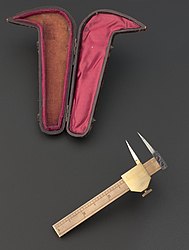Soubor:Aesthesiometer.jpeg
Obsah stránky není podporován v jiných jazycích.
Vzhled
Z Wikipedie, otevřené encyklopedie

Velikost tohoto náhledu: 453 × 599 pixelů. Jiná rozlišení: 181 × 240 pixelů | 363 × 480 pixelů | 580 × 768 pixelů | 1 161 × 1 536 pixelů.
Původní soubor (1 161 × 1 536 pixelů, velikost souboru: 117 KB, MIME typ: image/jpeg)
| Tento soubor pochází z Wikimedia Commons. Níže jsou zobrazeny informace, které obsahuje jeho tamější stránka s popisem souboru. |
Popis
Objekt
| Aesthesiometer
|
|||
|---|---|---|---|
| Název |
Aesthesiometer label QS:Len,"Aesthesiometer" |
||
| Sbírka |
|
||
| Reference URL InfoField | https://collection.sciencemuseumgroup.org.uk/objects/co8371967 | ||
Fotografie
| PopisAesthesiometer.jpeg | |||
| Zdroj | Science Museum Group | ||
| Autor | Science Museum Group Studio | ||
| Svolení (Užití tohoto souboru) |
Tento soubor podléhá licenci Creative Commons Uveďte autora-Zachovejte licenci 4.0 International
|
||
| Collection InfoField |
|

|
Platnost výše uvedené licence pro tento soubor, původně nahraný na externí stránku, zatím nebyla zkontrolována správcem ani posuzovatelem. Pro další informace vizte Category:License review needed.
|
Licence
Tento soubor podléhá licenci Creative Commons Uveďte autora-Zachovejte licenci 4.0 International
- Dílo smíte:
- šířit – kopírovat, distribuovat a sdělovat veřejnosti
- upravovat – pozměňovat, doplňovat, využívat celé nebo částečně v jiných dílech
- Za těchto podmínek:
- uveďte autora – Máte povinnost uvést autorství, poskytnout odkaz na licenci a uvést, pokud jste provedli změny. Toho můžete docílit jakýmkoli rozumným způsobem, avšak ne způsobem naznačujícím, že by poskytovatel licence schvaloval nebo podporoval vás nebo vaše užití díla.
- zachovejte licenci – Pokud tento materiál jakkoliv upravíte, přepracujete nebo použijete ve svém díle, musíte své příspěvky šířit pod stejnou nebo slučitelnou licencí jako originál.
Popisky
Přidejte jednořádkové vysvětlení, co tento soubor představuje
Эстезиометр
Položky vyobrazené v tomto souboru
zobrazuje
image/jpeg
1683c6a1daaa963f9728ffdc7cfc45f5b49837d8
119 560 bajt
1 536 pixel
1 161 pixel
Aesthesiometer angličtina
Historie souboru
Kliknutím na datum a čas se zobrazí tehdejší verze souboru.
| Datum a čas | Náhled | Rozměry | Uživatel | Komentář | |
|---|---|---|---|---|---|
| současná | 17. 7. 2022, 16:28 |  | 1 161 × 1 536 (117 KB) | Battleofalma | pattypan 22.03 |
Využití souboru
Tento soubor používá následující stránka:
Globální využití souboru
Tento soubor využívají následující wiki:
- Využití na en.wikipedia.org
- Využití na ko.wikipedia.org
- Využití na nl.wikipedia.org
- Využití na pl.wikipedia.org
- Využití na ru.wikipedia.org
- Využití na ur.wikipedia.org
- Využití na www.wikidata.org
Metadata
Tento soubor obsahuje dodatečné informace, poskytnuté zřejmě digitálním fotoaparátem nebo scannerem, kterým byl pořízen. Pokud byl soubor od té doby změněn, některé údaje mohou být neplatné.
| Krátký název | A606063 |
|---|---|
| Autor | Photographer, Jennie Hills |
| Držitel autorských práv | Science Museum, London| Science & Society Picture Library |
| Název obrázku | Aesthesiometer, Sieveking, brass and nickel, in leather case, from Parkes Weber collection, by Becker of London, 19th century. Skin sensitivity is tested, particularly in relation to touch, by an aesthesiometer. The instrument has a number of designs. This example is one of the simplest. It measures how far a patient could discriminate between two points on the skin. It is inscribed with the name of English physician Sir Edward Henry Sieveking (1816-1904). He invented this type of aesthesiometer in 1856. Sieveking was physician to Queen Victoria from 1873 onwards. He was knighted for his services aged 70. The object is from the collection of physician Frederick Parkes Weber (1863-1962). He wrote widely on dermatology (the study of the skin) and pathology. He also amassed a large coin collection, which is now at the British Museum. This instrument was made by F. E. Becker and Company of London. It is made from brass and nickel and has its original leather case. Overhead view of whole object against graduated grey background. |
| Poznámky ze souboru JPEG | Aesthesiometer, Sieveking, brass and nickel, in leather case, from Parkes Weber collection, by Becker of London, 19th century. Skin sensitivity is tested, particularly in relation to touch, by an aesthesiometer. The instrument has a number of designs. This example is one of the simplest. It measures how far a patient could discriminate between two points on the skin. It is inscribed with the name of English physician Sir Edward Henry Sieveking (1816-1904). He invented this type of aesthesiometer in 1856. Sieveking was physician to Queen Victoria from 1873 onwards. He was knighted for his services aged 70. The object is from the collection of physician Frederick Parkes Weber (1863-1962). He wrote widely on dermatology (the study of the skin) and pathology. He also amassed a large coin collection, which is now at the British Museum. This instrument was made by F. E. Becker and Company of London. It is made from brass and nickel and has its original leather case. Overhead view of whole object against graduated grey background. |
| Klíčová slova |
|



